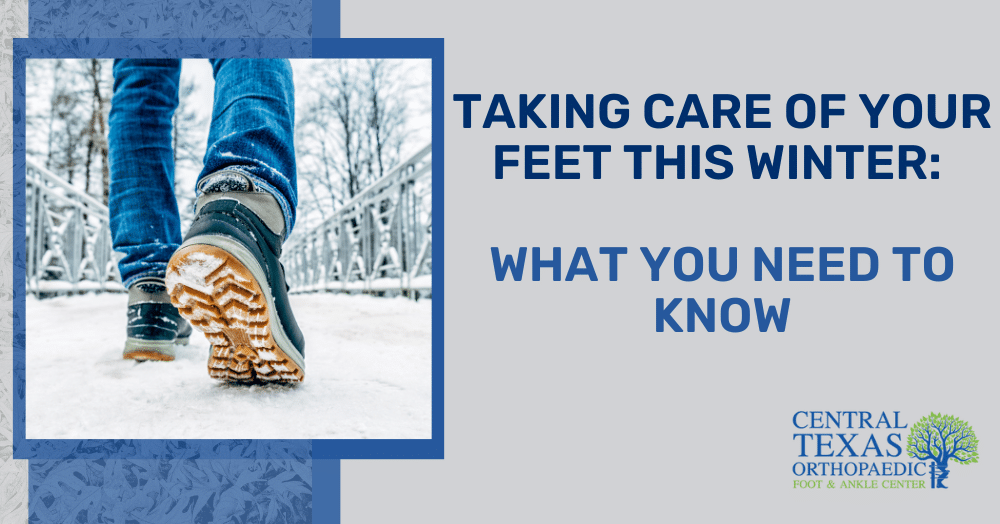Taking Care of Your Feet This Winter: What You Need to Know

As we prepare for winter’s cold temperatures and dry air, we must take a few extra measures to ensure our health from head to toe. Frigid temperatures can be cruel—especially to our extremities—and without healthy feet, our mobility and whole body health grows limited.
Foot care is even more imperative for those suffering from health conditions like diabetes, neuropathy, or anyone prone to infections. The great news is that foot care isn’t burdensome. A little extra attention goes miles!
We’ve compiled a few preventative tips to keep your feet happy, healthy, and to add a spring to your step—long before spring even begins.
Choose the Right Winter Footwear
Whether you’re taking a quick walk to the mailbox or going for a wintry hike, you can’t take your footwear choice for granted. You’ll need extra warmth, support, and traction.
Insulated boots with non-slip soles, proper arch support, and/or custom orthotics are just the beginning. Here are a few additional things to consider when choosing footwear this season.
Winter footwear should:
-
- Feel comfortable and support your arch—Shoes that fit well allow proper circulation and support. They should offer sufficient arch support to combat foot fatigue and pain.
-
- Provide Insulation—Water-resistant shoes or boots with extra warming layers will help keep feet dry and warm. This helps ward against frostbite, nerve pain, and other chilly discomforts.
-
- Always Have Traction—Your foot gear choices this winter should offer the right amount of traction on icy surfaces. Thick soles and deep treads give your feet a better grip with each step. Good traction supports proper stability and balance, keeping you on your feet while preventing strains and sprains.
Stay Hydrated—Even When It’s Cold
In winter, hydration can become an afterthought. We may not feel as thirsty when we’re cold, but that doesn’t mean we should skimp on water intake. Humans can still sweat and lose valuable water when all bundled up.
Essentially, the amount of water our bodies need to function doesn’t drop alongside the temperature.
When our bodies are cold, our blood vessels constrict to conserve heat. Constricted vessels slow blood circulation, especially in our feet and other extremities, leading to a lack of water and nutrients that can cause dry and cracked skin. Sufficient hydration helps maintain proper blood circulation and combats dry skin.
Here are a few ways to stay hydrated when it’s cold outside:
-
- Grab your favorite water bottle—Carrying a water bottle with you will remind you to drink throughout the day. Luckily, water bottles are ubiquitous and available in all sizes, shapes, and styles.
-
- Drink your lunch—A winter hydration routine doesn’t have to be limited to a water bottle. You can drink soups, broths, and eat water-rich fruits and vegetables to increase your fluid intake.
-
- Moisturize—Keeping up with good foot hygiene includes daily moisturizing. In cold, dry months, rubbing a thick lotion or petroleum jelly on clean feet will help to keep them moisturized and help dry skin heal itself.
Keep Your Socks and Feet Dry
Playing in the snow is one of winter’s greatest joys. Just make sure you have waterproof shoes or boots!
Wet feet are at risk of fungal infections, like athlete’s foot, which can cause itching, burning, cracked skin, and even blisters. Unfortunately, this can also happen when feet are warm and well-insulated and start sweating.
-
- Choose breathable socks—If too much sweating is making your socks moist, you can always bring extra socks and change them as needed. Alternatively, you can wear breathable, moisture-wicking socks and/or apply antifungal powder to help keep feet dry.
Prioritize Pedicures
Pedicures are a classic and effective way to take care of well-used feet. And while having a pedicure at a spa is nice, you can alternatively take care of your feet at home at no expense
Pedicures usually include a few important steps for maintaining foot health:
-
- Remove dead skin—Pedicure tools like buffers, foot rasps, and exfoliating scrubs help to remove dry, dead skin cells. This keeps feet from becoming overly dry, cracked, and prone to infections.
-
- Keep toenails clean and well-groomed—Trimmed toenails are necessary for comfortable, well-fitted shoes. Nails should be cut straight across-and not too short-to prevent ingrown toenails.
-
- Increase Circulation—Pedicures at the spa or at home can include massages, which increase blood circulation and hydration. Massages with lotions and oils further hydrate skin.
Foot Health All Year Round
Foot care isn’t a luxury—it’s a necessity. Fortunately, it doesn’t have to be overly involved or expensive to be effective. Resolving to maintain proper foot care this winter will set your feet up for the rest of the year.
When it’s time to don sandals and tennis shoes for those outdoor vacations and adventures in warmer weather, your feet will be ready!

